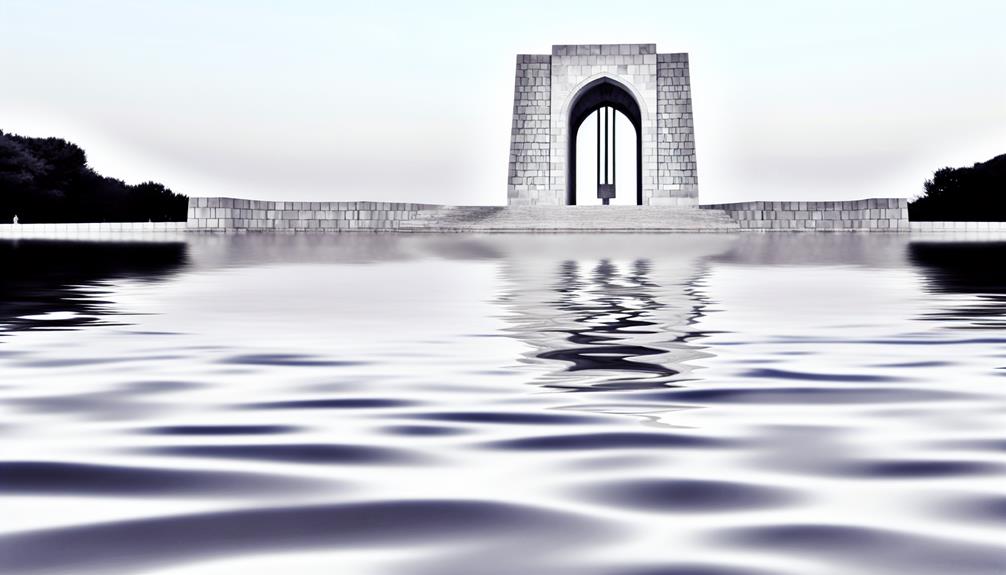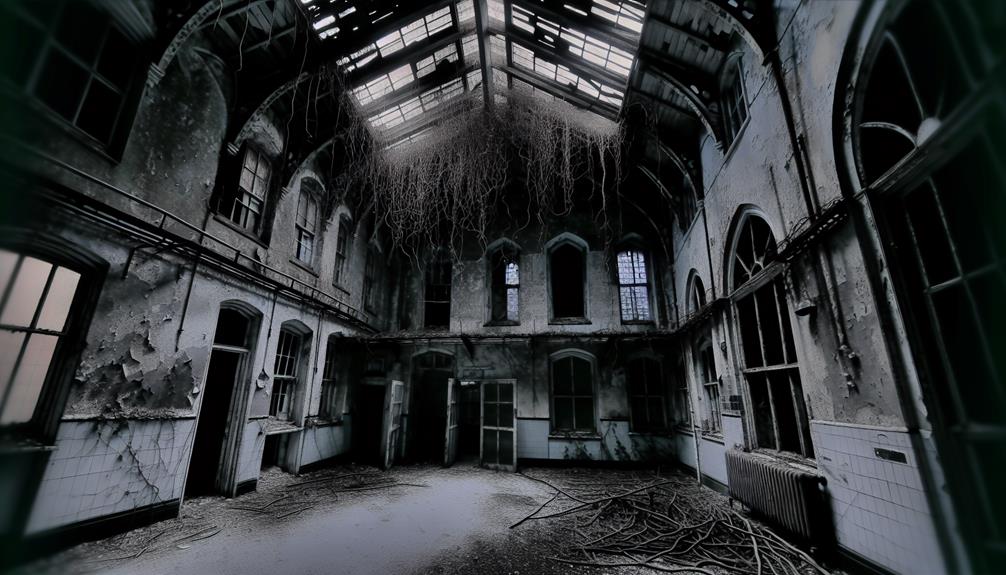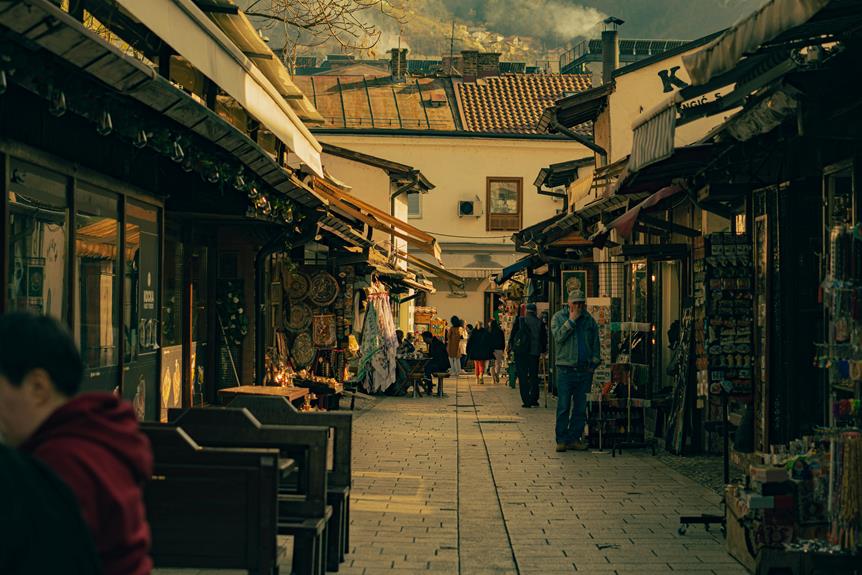The Hiroshima Peace Memorial stands as a somber reminder of a tragic chapter in human history, yet it also embodies a remarkable resilience that transcends the devastation of war. Stepping into this memorial site is akin to entering a domain where the echoes of the past mingle with the whispers of hope for a peaceful future. Each corner holds stories of pain, courage, and ultimately, the unwavering human spirit in the face of adversity. As visitors navigate through this poignant space, they are confronted with profound reflections on resilience that compel contemplation on the enduring power of remembrance and reconciliation.
Key Takeaways
- Hiroshima Peace Memorial symbolizes hope and healing.
- Genbaku Dome signifies human spirit amidst devastation.
- Survivor stories showcase resilience and courage.
- International efforts advocate for peace and reconciliation.
- Visiting offers reflection on resilience and peace advocacy.
The History Behind Hiroshima's Resilience
The enduring spirit of the people of Hiroshima, shaped by the city's tumultuous past, serves as a confirmation to human resilience in the face of unimaginable tragedy. The historical significance of Hiroshima is deeply rooted in the atomic bombing that occurred on August 6, 1945, during World War II. This event not only marked a devastating loss of life but also sparked a transformation in the city's identity. Hiroshima's resilience in rebuilding itself from the ashes of destruction showcases a remarkable cultural impact that resonates globally.
The city's history is a poignant reminder of the horrors of war and the enduring strength of the human spirit. The Hiroshima Peace Memorial, also known as the Genbaku Dome, stands as a symbol of hope and resilience amidst tragedy. Its designation as a UNESCO World Heritage Site underscores its historical significance and cultural impact, drawing visitors from around the world to reflect on the consequences of nuclear warfare.
The resilience of Hiroshima's people is evident in their commitment to peace, reconciliation, and the prevention of future atrocities. Through museums, memorials, and peace education initiatives, Hiroshima continues to share its story with the world, emphasizing the importance of understanding the past to build a more peaceful future. The city's ability to transform tragedy into a beacon of hope exemplifies the extraordinary resilience and strength of the human spirit.
Architectural Symbolism and Significance
Architectural symbolism and significance within the Hiroshima Peace Memorial encapsulate profound historical narratives that resonate globally, marking a pivotal representation of resilience and hope amidst tragedy. The architectural design of the Peace Memorial, primarily known as the Genbaku Dome or the Atomic Bomb Dome, stands as a poignant reminder of the destructive power of nuclear weapons. Originally designed by Czech architect Jan Letzel, the building's skeletal remains after the atomic bombing have been preserved to symbolize the enduring impact of the tragic event.
The symbolic representation embedded in the Peace Memorial extends beyond its physical structure. The dome, with its partially collapsed roof and exposed framework, serves as a poignant metaphor for both the devastation caused by the atomic bomb and the strength of the human spirit to rebuild and heal. Visitors often describe a profound sense of solemnity and reflection when standing in the presence of this architectural relic, fostering a deep connection to the past while emphasizing the importance of peace and reconciliation.
Moreover, the Peace Memorial's architectural significance lies in its role as a beacon of hope and healing. The site has become a symbol of peace and a demonstration of the resilience of the people of Hiroshima. It serves as a powerful reminder of the catastrophic consequences of war while advocating for a future built on understanding, cooperation, and peace.
Impact of the Atomic Bombing
Having altered the course of history, the atomic bombing of Hiroshima in 1945 left a profound and enduring impact on the city and its inhabitants. The long-term effects of the atomic bombing were devastating, with immediate casualties estimated at around 140,000. However, the aftermath of the bombing continued to unfold over the years, with survivors facing increased risks of cancer, leukemia, and other radiation-related illnesses. The city's infrastructure was decimated, leading to a prolonged period of recovery and reconstruction.
Personal accounts from survivors offer harrowing insights into the human cost of the bombing. Stories of loss, suffering, and resilience paint a vivid picture of the trauma experienced by those who lived through the attack. Many survivors continue to grapple with physical and psychological scars, highlighting the enduring impact of the atomic bombing on individuals and communities.
The impact of the atomic bombing extended beyond physical health, affecting social and economic structures in Hiroshima. Families were torn apart, livelihoods were destroyed, and the city's social fabric was irrevocably altered. The memory of the bombing remains a central part of Hiroshima's identity, shaping its collective consciousness and commitment to peace.
Stories of Survival and Hope
Amidst the harrowing aftermath of the atomic bombing of Hiroshima in 1945, narratives of survival and resilience emerge as evidence to the enduring human spirit. Survivor testimonials from those who experienced the catastrophic event firsthand provide poignant insights into the strength and determination displayed in the face of unimaginable adversity. These accounts offer a glimpse into the harrowing experiences of individuals who defied the odds and found the will to carry on despite overwhelming challenges.
The stories of survival and hope highlight the profound impact of community support in the aftermath of the bombing. In the wake of such a devastating tragedy, the Hiroshima community rallied together to provide aid, comfort, and solidarity to those in need. Acts of kindness, compassion, and solidarity emerged as beacons of light in the darkness, showcasing the resilience and compassion that define the human spirit.
Through these stories, we are reminded of the power of solidarity and the resilience of the human spirit in the face of adversity. The survivor accounts serve as a reflection of the strength and courage of those who endured unimaginable suffering, yet found hope and solace in the support of their communities. In these narratives, we find inspiration and a powerful reminder of the capacity for human kindness and compassion, even in the most challenging of circumstances.
Reflecting on Global Peace Efforts
Reflecting on the current state of global peace efforts reveals a complex landscape marked by diplomatic negotiations, international collaborations, and ongoing challenges in conflict resolution. Peace initiatives are essential in fostering harmony among nations. Various organizations, such as the United Nations and the European Union, play pivotal roles in promoting peace through dialogue, mediation, and peacekeeping missions. International cooperation is crucial in addressing global conflicts and ensuring stability worldwide.
One of the significant challenges in achieving global peace is nuclear disarmament. The proliferation of nuclear weapons poses a severe threat to international security. Countries with nuclear capabilities must engage in diplomatic relations to reduce their arsenals and prevent the spread of these destructive weapons. Efforts such as the Treaty on the Non-Proliferation of Nuclear Weapons (NPT) aim to curb the development and use of nuclear arms, emphasizing the importance of disarmament in maintaining global peace.
Diplomatic relations are fundamental in resolving conflicts peacefully. Dialogue and negotiations between countries help prevent tensions from escalating into armed conflicts. Building trust and understanding through diplomatic channels is essential in fostering peaceful resolutions to disputes. Strong diplomatic ties promote cooperation and collaboration, leading to conflict resolution through peaceful means.
Artifacts and Exhibits at the Memorial
The Hiroshima Peace Memorial features a collection of poignant artifacts and exhibits that serve as powerful reminders of the devastating impact of nuclear warfare. These symbolic artifacts and historical exhibits within the memorial grounds provide visitors with a profound insight into the horrors faced by the people of Hiroshima.
- Sadako Sasaki's Origami Cranes: One of the most iconic symbols of peace, Sadako's origami cranes represent hope and resilience amidst tragedy.
- Atomic Bomb Dome: The skeletal remains of the Hiroshima Prefectural Industrial Promotion Hall, the Atomic Bomb Dome stands as a stark indication of the destructive power of nuclear weapons.
- Personal Belongings: Displayed personal items like clothing, watches, and school bags offer a glimpse into the daily lives abruptly halted by the atomic bombing.
- Survivor Stories: Through recorded testimonies and written accounts, visitors can learn about the firsthand experiences of survivors, shedding light on the human toll of the bombing.
- Photographic Archives: A collection of photographs documenting the immediate aftermath of the bombing and the subsequent efforts towards rebuilding serves as a visual historical record for visitors.
Each artifact and exhibit at the Hiroshima Peace Memorial contributes to a narrative of remembrance, reflection, and the ongoing pursuit of global peace.
Honoring the Legacy of Resilience
Honoring the legacy of resilience demonstrated by the survivors and the community of Hiroshima is paramount in understanding the enduring impact of the atomic bombing. The legacy of resilience is deeply ingrained in the fabric of Hiroshima, symbolizing the strength and fortitude of those who endured unimaginable suffering. Through acts of remembrance, the stories of survival and courage are passed down through generations, guaranteeing that the lessons learned from the tragedy are never forgotten.
The Hiroshima Peace Memorial stands as a tribute to the resilience of the human spirit in the face of adversity. Visitors to the memorial are reminded of the horrors of war but also of the hope that arises from the ashes of destruction. The memorial serves as a focal point for honoring the legacy of resilience, offering a space for quiet reflection and contemplation.
In paying homage to the legacy of resilience, it is essential to acknowledge the sacrifices made by those who experienced the atomic bombing firsthand. Their courage and determination to rebuild their lives and communities serve as a beacon of inspiration for future generations. By preserving their stories and honoring their memory, we make sure that the legacy of resilience continues to inspire acts of peace and reconciliation around the world.
Frequently Asked Questions
How Has the Hiroshima Peace Memorial Influenced Modern Architecture?
The Hiroshima Peace Memorial has profoundly influenced modern architecture through its innovative designs and promotion of sustainable practices. Architects have drawn inspiration from the Memorial's symbolic significance and incorporated elements of peace, harmony, and resilience into their projects.
This influence has led to a shift towards more environmentally conscious and socially responsible architectural approaches, reflecting a broader global movement towards sustainable design principles in the contemporary built environment.
Are There Any Interactive Exhibits at the Hiroshima Peace Memorial?
The Hiroshima Peace Memorial offers a range of interactive experiences and educational programs for visitors. These include:
- Virtual exhibits
- Survivor testimonies
- Multimedia displays
These elements provide insight into the events of the atomic bombing. Through these interactive elements, visitors can engage with history on a personal level, gaining a deeper understanding of the impact of the nuclear attack and the importance of promoting peace and nuclear disarmament.
What Initiatives Support Global Peace Movements Post-Hiroshima Bombing?
In the aftermath of the Hiroshima bombing, initiatives supporting global peace movements have emerged, emphasizing peace education and diplomatic efforts. These initiatives aim to promote understanding, tolerance, and conflict resolution.
Additionally, efforts towards nuclear disarmament and providing humanitarian aid to affected regions have been vital in fostering a culture of peace and preventing future atrocities.
Through these combined endeavors, the world continues to work towards a more peaceful and harmonious coexistence.
Can Visitors Leave Offerings or Tributes at the Memorial Site?
Visitors to the Hiroshima Peace Memorial can indeed leave offerings and tributes at the site. This act is a significant part of the offering traditions associated with the memorial.
These gestures of remembrance and respect allow visitors to pay their respects to the victims of the atomic bombing and to contribute to the ongoing legacy of peace and reconciliation that the memorial represents.
The practice of leaving tributes is a heartfelt way for visitors to honor the memory of those affected by the tragic event.
Has the Hiroshima Peace Memorial Received Any Significant Awards or Recognition?
The Hiroshima Peace Memorial, also known as the Genbaku Dome, has garnered significant awards and recognition for its architectural impact and historical significance. Awards such as the UNESCO World Heritage Site designation and the recognition as a symbol of resilience and peace by various organizations underscore its global importance.
The structure stands as a poignant reminder of the devastation caused by the atomic bomb, serving as a beacon of hope and a call for peace.
Conclusion
To sum up, the Hiroshima Peace Memorial stands as a towering tribute to the indomitable human spirit in the face of unspeakable tragedy. Its architectural significance and historical importance serve as a stark reminder of the devastating impact of war, while also inspiring hope for a future of peace and reconciliation.
The stories of survival and resilience showcased within its walls echo through the ages, serving as a powerful beacon of healing and unity for generations to come.


